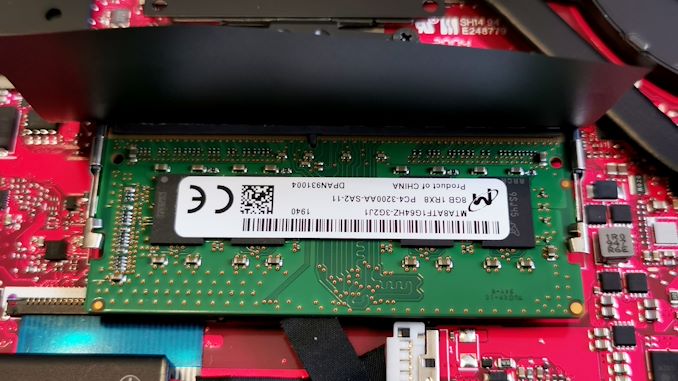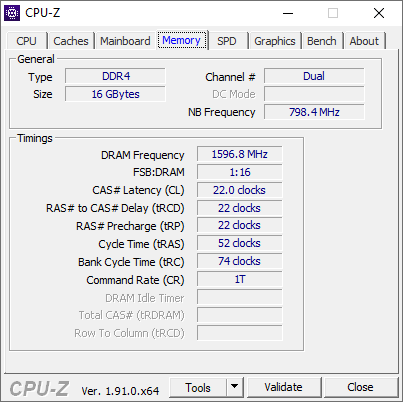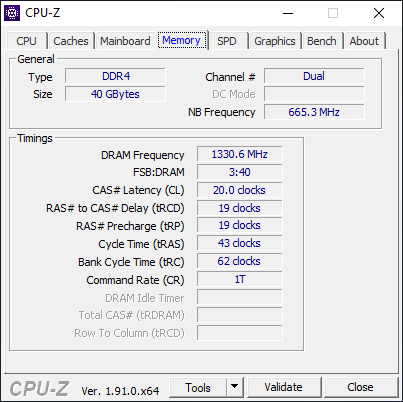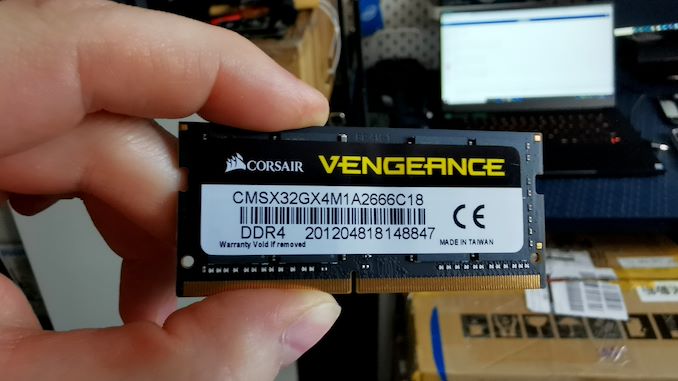AMD’s Mobile Revival: Redefining the Notebook Business with the Ryzen 9 4900HS (A Review)
by Dr. Ian Cutress on April 9, 2020 9:00 AM ESTRyzen 9 4900HS with DDR4-2666 and DDR4-3000
In our ASUS Zephyrus G14, we have a total of 16 GB of DDR4. This is split between a single SO-DIMM module of 8 GB, and a set of 8 GB memory soldered onto the board. AMD will offer a version with 16 / 16, however this might come at a later date.
This memory is running at the AMD recommended for these processors, DDR4-3200. Through our inspection tools, we can tell that this memory is running with subtimings of 22-22-22 with a command rate of 1T. The command rate is certainly good, however the 22-22-22 is a little slower than what we see on a desktop system running at this speed, because here we have a system that conforms to JEDEC’s subtiming requirements.
For our memory testing we wanted to see what speeds and capacities we could achieve. Corsair very kindly sent us some modules of 16 GB DDR4-3000 and a module of 32 GB DDR4-2666. This would give our system either 24 GB or 40 GB total respectively, which for a machine designed to do heavier duty workloads, having >16 GB is certainly welcome, as long as the performance hit isn’t too much.
I installed the 32 GB module, and the system booted first time with no fuss. A quick look to see if all the capacity was seen, and we had a total of 40 GB. The speed was also as expected, at DDR4-2666 but with subtimings of 20-19-19 1T.
However, when we put in the module of 16 GB DDR4-3000, to get a total of 24 GB, the detected speed inside the system was only DDR4-2666. Looking at the module settings, this was because the DDR4-3000 speed was actually an XMP profile, and ASUS has not enabled the ability to set XMP profiles here.
We were able to get DDR4-2666 on the 32 GB module because this is the base frequency and settings for the module. The same with the 8 GB module that came with the system – it was flashed so that the basic SPD setting was DDR4-3200. If users want to get high capacity modules with the faster DRAM speeds on this system, they will have to configure the primary SPD profile of their modules, which isn’t an easy thing to do.
As a result, our tests are going to come down to the 8 GB DDR4-3200 module that came with the system, and compare it to the 32 GB DDR4-2666 module. Note that the latter is an 8+32 configuration, which is expected to run in dual channel for the first 16 GB, and then single channel for the next 24 GB.



With our AI test, there’s a ~20% benefit from having the faster memory, which decreases slightly when moved to a limited power budget.

We didn’t see any difference in something like Cinebench.

There was more of a difference in PCMark 10, however PCM10 isn't that great in showing where the bottlenecks are.
Integrated Graphics Tests


For the Civ 6 graphics test, the difference in performance between the two memory settings is really significant. This sort of game cares less about FPS, however going down to 22 FPS for 1080p Max and No MSAA means that the user probably has to dial that back a bit to get something more reasonable.


Going from plugged in to not plugged in, we didn’t see much of a change with the slower memory, however the DDR4-3200 setting still gets a serious benefit over the DDR4-2666 arrangement.

For Final Fantasy, there a significant change - moving up from DDR4-2666 to DDR4-3200 affords a +30% improvement.
Discrete Graphics Tests




In each case, the faster DRAM actually improves discrete graphics performance.
Quick Thoughts
Overall, 16 GB of memory in a system like this isn't the best configuration - people who need the power are going to likely want 32 GB. However, users putting in their own fast module when buying the 16 GB version are going to have to be careful about the performance. Both the integrated graphics and the discrete graphics take a knock on performance going down from DDR4-3200 to DDR4-2666.















267 Comments
View All Comments
Deicidium369 - Monday, April 13, 2020 - link
"Revenues do not lie. " of course they dont, specially when you overcharge for your products"The market says otherwise, they think the products are well priced, and Intel sells all they can make - so just because YOU can't afford them doesn't mean they are over priced - and if they were sooo overpriced, seems like AMD would be in MUCH better financial situation than they are.
Qasar - Monday, April 13, 2020 - link
again prove it, look at the 3 links i posted farther up. yea..right well priced, over priced is more like it, Epyc Rome, more cores, it some cases HALF the price, and better performance.schujj07 - Tuesday, April 14, 2020 - link
Revenue actually does lie. Look at the mid 2000s when the Athlon 64 was king. Intel was still making money hand over fist because of shady business practices. When you are the 800lbs gorilla, you can throw your weight around and make sure that people only buy your product even if it is inferior.alufan - Monday, April 13, 2020 - link
lets revisit this comment in 12 months shall we as an example my company has a worldwide base of 60k plus they just moved all future buys to AMD the tide is turning and frankly its about time, intel will return and frankly i hope they do because competition is good for us the consumer but right now face it AMD simply has the better product in all ways maybe apart from one or two specilist benchs or workloads where intel has funded the software development and provided a chip to do the workNamisecond - Monday, April 13, 2020 - link
AMD probably does have the "better" product in just about all the fields. But can they step in and significantly eat into Intel's market share? I don't think so. AMD's production capability is currently limited and not in their control.Qasar - Monday, April 13, 2020 - link
" But can they step in and significantly eat into Intel's market share? " i think that is slowly starting to happenDeicidium369 - Monday, April 13, 2020 - link
Yup been happening for like 40 years - so far upto mid single digits.. AMD is a 2 trick pony and you almost can't build an AMD laptop/desktop without sending Intel some $$$Qasar - Friday, April 10, 2020 - link
ahh Gondalf, trying anything and everything to try to make your god of cpus look better, huh ? i find it crazy that you just cant except amd has the better product. give it up already, pathetic intel fanboyDeicidium369 - Sunday, April 12, 2020 - link
ahh Qasar, trying anything and everything to try to make your god of cpus look better, huh ? i find it crazy that you just cant except* Intel has the better product. give it up already, pathetic AMD fanboy*accept.
Qasar - Sunday, April 12, 2020 - link
ahh Deicidium369 i find it crazy you are the one that cant except it. amd has the better product now, most reviews have shown that. give it up already, pathetic Intel fanboy